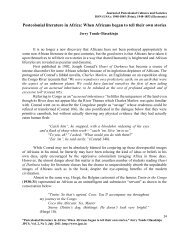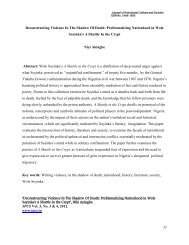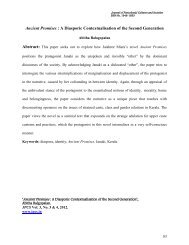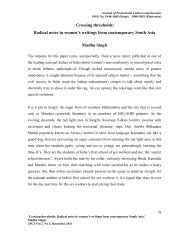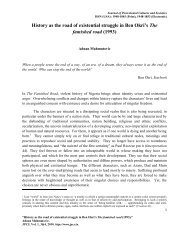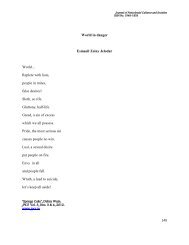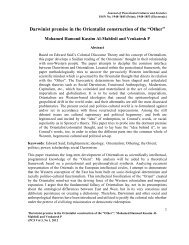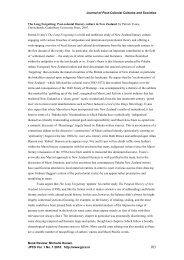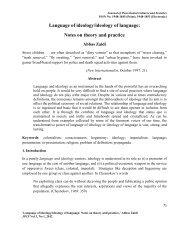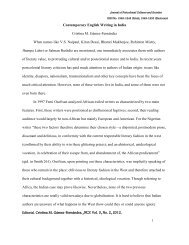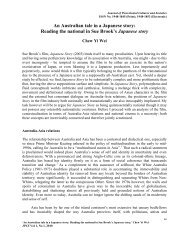The seeds of violence in domesticity: The case of post ... - JPCS
The seeds of violence in domesticity: The case of post ... - JPCS
The seeds of violence in domesticity: The case of post ... - JPCS
Create successful ePaper yourself
Turn your PDF publications into a flip-book with our unique Google optimized e-Paper software.
Journal <strong>of</strong> Postcolonial Cultures and Societies<br />
ISSN (USA): 1948-1845 (Pr<strong>in</strong>t), 1948-1853 (Electronic)<br />
<strong>The</strong> <strong>seeds</strong> <strong>of</strong> <strong>violence</strong> <strong>in</strong> <strong>domesticity</strong>: <strong>The</strong> <strong>case</strong> <strong>of</strong> <strong>post</strong>-Independence India<br />
Alessandro Monti<br />
In the f<strong>in</strong>al sequence <strong>of</strong> the H<strong>in</strong>di film Dharmaputra (1961), when India is deep <strong>in</strong> the<br />
miscarry<strong>in</strong>g throes <strong>of</strong> Partition, Nehru is seen and heard say<strong>in</strong>g that are Indians all those who<br />
want to be such. This statement <strong>in</strong>structs <strong>in</strong>clusion and at the same times establishes implied<br />
norms <strong>of</strong> belong<strong>in</strong>g. What is the real mean<strong>in</strong>g <strong>of</strong> Indianness? Which specific, and perhaps<br />
discrim<strong>in</strong>at<strong>in</strong>g, characters are requested for select <strong>in</strong>clusion? Com<strong>in</strong>g back to the film, Nehru’s<br />
declaration <strong>of</strong> corporate identity concludes and <strong>in</strong> some way seals the eukumenic happy end<strong>in</strong>g<br />
<strong>of</strong> the story, <strong>in</strong> which a Muslim boy (now a militant young man) born <strong>of</strong> an unwed daughter <strong>of</strong> a<br />
nawab is adopted by a friendly H<strong>in</strong>du couple. <strong>The</strong> boy grows up to a fanatic anti-Muslim<br />
fundamentalist, notwithstand<strong>in</strong>g the mild attitude nurtured by his adoptive family circle. He<br />
would kill his parents (which are unknown to him as such) and burn down their house. His true<br />
identity is f<strong>in</strong>ally revealed to him and he sees himself as someone non-existent, a blank file <strong>in</strong> the<br />
maiden archive <strong>of</strong> Indian Nationhood.<br />
However his temporary <strong>in</strong>visibility (one which is restored to accepted identity thanks to<br />
the love <strong>of</strong> a H<strong>in</strong>du woman) <strong>in</strong>dicates how the words spoken to the nation by Nehru move <strong>in</strong> the<br />
sphere <strong>of</strong> pre-modern toleration, rather than tolerance, and suggest or rather require a<br />
presumption <strong>of</strong> general acceptance. As a matter <strong>of</strong> fact this pronunciation reflects the major<br />
refusal <strong>of</strong> shared belong<strong>in</strong>g <strong>in</strong> difference which is at the roots <strong>of</strong> the split between India and<br />
Pakistan. We should consider aga<strong>in</strong> what happens <strong>in</strong> Dharmaputra – apparently it revolves<br />
around a comprehensive metaphor <strong>of</strong> unity through difference which is illustrated by the bridge<br />
that connects the two adjon<strong>in</strong>g homes, the H<strong>in</strong>du and the Muslim. This bridge allows<br />
communication and coexistence between the two cultures and ways <strong>of</strong> life withouts their actual<br />
merg<strong>in</strong>g together – it generates measures <strong>of</strong> reciprocate neighbourhood but not really<br />
comprehensive transitions <strong>of</strong> culture. <strong>The</strong> lifelong friendship <strong>of</strong> the two families, <strong>in</strong>clud<strong>in</strong>g<br />
respectively a modernized H<strong>in</strong>du (a medical man) and a more formal household, still imbued<br />
with the traditional Nawabi heritage, does <strong>in</strong>volve the hegemonic stiffness <strong>of</strong> culture rather then<br />
the possibility <strong>of</strong> mov<strong>in</strong>g across it.<br />
<strong>The</strong>ir relationship is simply one <strong>of</strong> agglomeration, one which yields to assimilation when<br />
the need to <strong>in</strong>clude arises. So, the Muslim adopted boy is turned <strong>in</strong>to a H<strong>in</strong>du: his transfer <strong>of</strong><br />
identity does not safeguard difference <strong>in</strong> the <strong>in</strong>dividual and replaces conformity for tolerance.<br />
Such an <strong>in</strong>transitive feature constitutes perhaps the determ<strong>in</strong>ative character that lies at the very<br />
heart <strong>of</strong> nationalistic <strong>in</strong>structed Indianess. <strong>The</strong> signifier for corporate identity takes charge <strong>of</strong> the<br />
tw<strong>of</strong>old aspect <strong>in</strong> a way that both absorbs the literal plea for a coterm<strong>in</strong>ous acceptance and<br />
ma<strong>in</strong>ta<strong>in</strong>s the archaic refusal to <strong>in</strong>tegrate. <strong>The</strong> cont<strong>in</strong>ued dist<strong>in</strong>ction <strong>in</strong> unity will lead to rampant<br />
communalism, whose ideological (or religious m<strong>in</strong>dset) aim purposes to achieve uniformity<br />
through <strong>violence</strong>.<br />
In Dharmaputra H<strong>in</strong>du fanaticism wants to erase contiguity and co-presence <strong>in</strong> culture by<br />
destroy<strong>in</strong>g the Muslim portion <strong>of</strong> the symbolically jo<strong>in</strong>t household. This cleas<strong>in</strong>g purification by<br />
fire extends the diasporic movement consequent to Partition from the outside rejection that<br />
enforces people to migrate to domestic extraneous marg<strong>in</strong>ality. This pattern reject<strong>in</strong>g extensive<br />
81<br />
“<strong>The</strong> <strong>seeds</strong> <strong>of</strong> <strong>violence</strong> <strong>in</strong> <strong>domesticity</strong>: <strong>The</strong> <strong>case</strong> <strong>of</strong> <strong>post</strong>-Independence India,” Alessandro Monti<br />
<strong>JPCS</strong>, Vol. 2, No 3, July 2011. http://www.jpcs.<strong>in</strong>
Journal <strong>of</strong> Postcolonial Cultures and Societies<br />
ISSN (USA): 1948-1845 (Pr<strong>in</strong>t), 1948-1853 (Electronic)<br />
conformity out <strong>of</strong> the corporate archive <strong>of</strong> nationhood needs an agency mediat<strong>in</strong>g uniformity: the<br />
refusal <strong>of</strong> a national eukumene imposes a regulative device, one which would be able to act at a<br />
horizontally extended but closely controlled level. Thus the basic procedures <strong>of</strong> <strong>in</strong>clusion and<br />
exclusion are delegated to the authority <strong>of</strong> the traditional family circle through the control <strong>of</strong><br />
<strong>in</strong>dividual behaviour and the imposition <strong>of</strong> pre-orda<strong>in</strong>ed patterns <strong>of</strong> identity, which constitute a<br />
consequent specific character <strong>of</strong> Indianness.<br />
This double edge both implies toleration and at the same requests conformity. Toleration<br />
is conveyed <strong>in</strong> the film by the domestic bridge – <strong>of</strong> course a two-way passage from one house to<br />
the other, but an episodic <strong>in</strong>terconnection not meant family people to opt <strong>in</strong> or out <strong>of</strong> their<br />
specific cultural frameworks. <strong>The</strong> H<strong>in</strong>du young man born unknow<strong>in</strong>gly to him a Muslim<br />
<strong>in</strong>scribes fanaticism <strong>in</strong> his cultural code, as an excessive sign <strong>of</strong> adhesion to a found<strong>in</strong>g notion <strong>of</strong><br />
corporate purity. Thus the only <strong>in</strong>stance <strong>in</strong> the film <strong>of</strong> full transition with<strong>in</strong> a presumptive unity<br />
leads to a personal behaviour <strong>of</strong> rupture and separation. It would perhaps be possible to analyze<br />
the feel<strong>in</strong>g <strong>of</strong> active hostility thrust forward by the young man as a confused mnestic semiawareness<br />
<strong>of</strong> his dim<strong>in</strong>ished identity as a nagari, a citizen <strong>of</strong> the nation. To him not bee<strong>in</strong>g a<br />
H<strong>in</strong>du means separation from himself, a personal Partition which makes him remember his own<br />
true identity as a lost and non-existent self.<br />
<strong>The</strong> partitioned condition <strong>of</strong> this character <strong>in</strong>dicates exile with<strong>in</strong> or shared nationhood, a<br />
status which might equated to what happened to the refugees at the Partition. We could possibly<br />
quote a recent collection <strong>of</strong> S<strong>in</strong>dhi short stories, Unbordered Memories (2009), <strong>in</strong> which the<br />
enforced separation from the native regional place endorses loss and estrangement. This attitude<br />
generates a retrospective and f<strong>in</strong>ally regressive time-lag which erases the present from any<br />
positive consciousness, by substitut<strong>in</strong>g it with abstract culture (or its alter egoes, religion or<br />
ethnicity or whatever k<strong>in</strong>d <strong>of</strong> belong<strong>in</strong>g <strong>in</strong> the social sphere), so as to make the subject live and<br />
act <strong>in</strong> a static vacuum. We might take what happens to the Muslim boy <strong>in</strong> the film as an extended<br />
metaphor <strong>of</strong> pre-modern tolerance, one which emphasizes culture, religion, ethnicity et alia as<br />
values that cannot be exchanged or mediated and fully <strong>in</strong>tegrated one another.<br />
To ensure legitimacy <strong>in</strong> nationhood the <strong>in</strong>vention <strong>of</strong> H<strong>in</strong>dustan as a select land (“a very<br />
good country” as a man <strong>in</strong> a Benares gully whispered to the pass<strong>in</strong>g-by foreigners), the<br />
<strong>in</strong>strumental choice <strong>of</strong> <strong>domesticity</strong> as an added moral value was and still is the corporate agency<br />
for the general effort to control society and make it homogeneous. Domesticity meant and still<br />
means the refusal <strong>of</strong> Western ways <strong>in</strong> private life and the emphasis <strong>of</strong> difference <strong>in</strong> morality. So<br />
difference becomes the characteriz<strong>in</strong>g all-mark <strong>of</strong> identity <strong>in</strong> the Independent Indian nation.<br />
However, <strong>in</strong> this discourse difference assumes a restricted mean<strong>in</strong>g s<strong>in</strong>ce it does not entail a<br />
horizontal spread<strong>in</strong>g, one which would allow transversal <strong>in</strong>tersections with<strong>in</strong> the multi-faced<br />
national communities, but fosters <strong>in</strong> its stead a hierarchical pyramid.<br />
Of this structural division <strong>in</strong> the national body casteism constitutes undoubtedly the most<br />
blatant and usavoury side. <strong>The</strong> question is set rather sentimentally <strong>in</strong> the film Sujata (1960), <strong>in</strong><br />
which the issue <strong>of</strong> adoption (an untouchable orphaned girl jo<strong>in</strong>s a high-caste family) highlights<br />
her controversial domestic status, simultaneously <strong>of</strong> someone which is <strong>in</strong>side or outside the<br />
authorized family circle. <strong>The</strong> emotional tension <strong>in</strong> the film splits the young woman <strong>in</strong> the<br />
domestic text between a daughter <strong>of</strong> the house and an embarass<strong>in</strong>g outcaste whose role cannot<br />
actually exceed the subaltern position <strong>of</strong> a servant. This further <strong>in</strong>stance <strong>of</strong> toleration with<strong>in</strong> the<br />
social range cuts at least symbolically across the guidel<strong>in</strong>es <strong>of</strong> which will be the politics <strong>of</strong><br />
“<strong>The</strong> <strong>seeds</strong> <strong>of</strong> <strong>violence</strong> <strong>in</strong> <strong>domesticity</strong>: <strong>The</strong> <strong>case</strong> <strong>of</strong> <strong>post</strong>-Independence India,” Alessandro Monti<br />
<strong>JPCS</strong>, Vol. 2, No 3, July 2011. http://www.jpcs.<strong>in</strong><br />
82
Journal <strong>of</strong> Postcolonial Cultures and Societies<br />
ISSN (USA): 1948-1845 (Pr<strong>in</strong>t), 1948-1853 (Electronic)<br />
reservation concern<strong>in</strong>g the so-called Backwards started by the Mandal commission s<strong>in</strong>ce the<br />
1990s (hence the mandalisation <strong>of</strong> India). If the debate <strong>in</strong> the film on the possible <strong>in</strong>clusive value<br />
<strong>of</strong> family adoption might recall communalism, one can wonder if the passage from the domestic<br />
(or family) circle would <strong>in</strong>struct de facto dissimilarity or cont<strong>in</strong>uity.<br />
<strong>The</strong> answer to this query should consider how the honour <strong>of</strong> a family depends on the<br />
identity <strong>of</strong> its acquired members. Thus <strong>in</strong> the 70s Indian c<strong>in</strong>ema dealt extensively with the theme<br />
<strong>of</strong> a daughter-<strong>in</strong>-law which because <strong>of</strong> various reasons had entered the family circle with an<br />
assumed identity. Such is, for example, the dramatic kernel <strong>of</strong> Kati Patang (1970) <strong>in</strong> which a<br />
missed bride, on the run the very hour <strong>of</strong> her marriage, replaces a widowed friend <strong>of</strong> hers, also a<br />
mother, who dies <strong>in</strong> a tra<strong>in</strong> crash after their casual meet<strong>in</strong>g. An extension <strong>of</strong> this plot <strong>in</strong>volves a<br />
mother who is obliged to leave her newborn. She jo<strong>in</strong>s the adoptive family as an ayah, <strong>in</strong> order<br />
not to be separated from her child, usually a boy. In Aradhana (1969) she even charges herself<br />
with murder <strong>in</strong> order to protect her boy.<br />
It would be deeply wrong to evaluate these films on sheer terms <strong>of</strong> melodrama. <strong>The</strong>y are<br />
above all concerned with homogeneity with<strong>in</strong> the social body and the assessment <strong>of</strong> a true<br />
acceptable identity. To this purpose they mediate between the <strong>in</strong>ner, or oikumenic, circle<br />
represented by the extended family group, and the external, or eukumenic, nation-state. Outside<br />
this rul<strong>in</strong>g basic connection, one which authorizes authority through the domestic micro-cell, a<br />
dissem<strong>in</strong>ation <strong>of</strong> power, or powers, endorses self-authorizations. <strong>The</strong> patriarchal bias, for<br />
<strong>in</strong>stance <strong>of</strong> Indian society generates non only domestic <strong>violence</strong> or an excess <strong>in</strong> rapes, or <strong>in</strong> the<br />
so-called honour kill<strong>in</strong>gs but also stands as the primary cause for baby-girl foeticide. This<br />
malpractice can be viewed as a misuse or an abuse <strong>of</strong> domestic authority, s<strong>in</strong>ce it is aimed at<br />
ma<strong>in</strong>ta<strong>in</strong><strong>in</strong>g the social level <strong>of</strong> a family or at gett<strong>in</strong>g rid <strong>of</strong> an obstacle towards a sh<strong>in</strong><strong>in</strong>g upwards<br />
progress.<br />
This behaviour also perta<strong>in</strong>s to the concerns for identity with<strong>in</strong> the domestic milieu, given<br />
its worry for social position. It still moves around the dichotomy <strong>in</strong>clusion-exclusion, <strong>in</strong> a way<br />
that enacts too pragmatically the clause <strong>of</strong> non-belong<strong>in</strong>g. Foeticide is meant to ma<strong>in</strong>ta<strong>in</strong> family<br />
status and consequently to preserve its honour. So, it cumulates responsibility on women even<br />
before their (refused) births by consider<strong>in</strong>g them duhitā (duh, milk), those who waste the<br />
resources <strong>of</strong> the family. This view <strong>in</strong>cludes the notion <strong>of</strong> arth, banally pr<strong>of</strong>it, but <strong>in</strong> a more<br />
complex perspective the care, ma<strong>in</strong>tenance and <strong>in</strong>crease <strong>of</strong> family wealth. This notion stands at<br />
the very heart <strong>of</strong> the fictional domestic sagas set <strong>in</strong> the merchants’ circle (bania); we should<br />
recall to the purpose the novels Home (2007) by Manju Kapur and Aftertaste (2010) by Namita<br />
Devidayal.<br />
It would be apparent by now that the concept <strong>of</strong> <strong>domesticity</strong> encloses a certa<strong>in</strong> amount <strong>of</strong><br />
<strong>violence</strong>, both <strong>in</strong> the defense and <strong>in</strong> the imposition <strong>of</strong> a certified morality and <strong>in</strong> the search for<br />
pr<strong>of</strong>it, as it occurs with the request <strong>of</strong> dowry. Marriages for dowry lead <strong>of</strong>ten to death for wives<br />
whose merciless reduction to cattle obliterates aga<strong>in</strong> the unstable border between life and death,<br />
as equally happens <strong>in</strong> the practice <strong>of</strong> foeticide. S<strong>in</strong>ce the dowry wives are assessed with regard to<br />
the money they br<strong>in</strong>g to the receiv<strong>in</strong>g family, they can be disposed <strong>of</strong> when their economical<br />
value ceases. However, these acts <strong>of</strong> violent expulsion from the domestic circle are not <strong>of</strong>ficially<br />
endorsed by the authority <strong>of</strong> the nation-state. As a matter <strong>of</strong> fact, while act<strong>in</strong>g, at least nom<strong>in</strong>ally,<br />
aga<strong>in</strong>st <strong>in</strong>dividual or group domestic <strong>violence</strong> and casteism the judicial body oscillates between<br />
punishment aga<strong>in</strong>st moral <strong>in</strong>fr<strong>in</strong>gement or, by matchmak<strong>in</strong>g <strong>in</strong> controversial elopements.<br />
“<strong>The</strong> <strong>seeds</strong> <strong>of</strong> <strong>violence</strong> <strong>in</strong> <strong>domesticity</strong>: <strong>The</strong> <strong>case</strong> <strong>of</strong> <strong>post</strong>-Independence India,” Alessandro Monti<br />
<strong>JPCS</strong>, Vol. 2, No 3, July 2011. http://www.jpcs.<strong>in</strong><br />
83
Journal <strong>of</strong> Postcolonial Cultures and Societies<br />
ISSN (USA): 1948-1845 (Pr<strong>in</strong>t), 1948-1853 (Electronic)<br />
<strong>The</strong> sphere <strong>of</strong> control may also <strong>in</strong>volve police prevention. Such is the <strong>case</strong> <strong>of</strong> a young<br />
couple surprised by a patrol at night <strong>in</strong> a village while talk<strong>in</strong>g. <strong>The</strong>y were identified and brought<br />
to the police station, where it appeared that they were plann<strong>in</strong>g elopment. Given the recurrence<br />
<strong>of</strong> such episodes, elopment has become an <strong>of</strong>fence, one equated to abduction. <strong>The</strong> exchange <strong>of</strong><br />
responsibilities between family and nation-state conceals what a newspaper has termed “caste<br />
drama”. <strong>The</strong> social status <strong>of</strong> the couple <strong>in</strong>dicates a double standard <strong>of</strong> hypergamy – as far as<br />
castes are concerned he is a brahm<strong>in</strong> (but a driver, so relatively low <strong>in</strong> the pr<strong>of</strong>essional<br />
hierarchies), whereas she, although be<strong>in</strong>g a dalit, is given as a <strong>post</strong>graduate. Hav<strong>in</strong>g eloped, the<br />
couple first married on November 23, 2010 (a second marriage took aga<strong>in</strong> place <strong>in</strong> early March<br />
2011), but when the girl came to know that the boy had lied to “her” apropos <strong>of</strong> his caste she<br />
filed crim<strong>in</strong>al charges aga<strong>in</strong>st him. A further side to the issue concerns the possible harassment,<br />
and eventually death, <strong>of</strong> a dalit wife <strong>in</strong> a brahm<strong>in</strong> household. In the H<strong>in</strong>dustan Times chronicle it<br />
is reported that “the police took an undertak<strong>in</strong>g from the youth’s family to make sure that<br />
noth<strong>in</strong>g wrong happened to Kiran Devi [the Dalit wife] later on”. After her son was sent to jail,<br />
“his mother Rami Devi filed a writ before the high court <strong>in</strong> January alleg<strong>in</strong>g that her son was the<br />
victim <strong>of</strong> police frame-up”. Later on “the girl expressed her desire to marry him and drop the<br />
charges”. (See Appendix 1, for a <strong>case</strong> <strong>of</strong> compulsory marriage, <strong>in</strong> which court and police<br />
authority substitute the family circle).<br />
Casteism and domestic harassment stand bleak at the background <strong>of</strong> the whole story, but<br />
a whole str<strong>in</strong>g <strong>of</strong> self-authoriz<strong>in</strong>g councils or self-styled courts stand <strong>in</strong>-between family circles<br />
and the authority <strong>of</strong> the nation-state. Among them are especially notorious the illegal khap<br />
panchayats, which ban women on wear<strong>in</strong>g jeans or punish, even with death, <strong>in</strong>tercaste<br />
marriages. <strong>The</strong> term khap (khāp, H<strong>in</strong>di, m/plu) can mean group, tribe and designates councils<br />
based on caste and on the respect <strong>of</strong> its norms. <strong>The</strong>ir authority, together with a host <strong>of</strong> similar<br />
grass-root <strong>in</strong>stitutions puts well to light the dissem<strong>in</strong>ation <strong>of</strong> authorities which is typical <strong>of</strong> the<br />
H<strong>in</strong>du society. (See Appendix 2). This fragmentation, on decentralization <strong>of</strong> responsibilities, is<br />
partly co<strong>in</strong>cident <strong>in</strong> purpose and values with the power <strong>of</strong> the nation-state, but <strong>in</strong> most <strong>case</strong>s<br />
<strong>in</strong>terpretates and enacts a stiff conformity to backward tradition. <strong>The</strong>y stand <strong>in</strong>-between the<br />
<strong>in</strong>timations <strong>of</strong> corporate morality (behaviour) operated via nationalism by the nation-state and<br />
the networks <strong>of</strong> micro-social organisms represented by the extended families.<br />
In some ways and matters (especially when rape is concerned) they substitute absentee<br />
<strong>of</strong>ficers <strong>of</strong> police, but as a rule they guarantee such issues as modesty <strong>in</strong> dress<strong>in</strong>g and <strong>in</strong>tervene<br />
for a further and f<strong>in</strong>al safeguard <strong>of</strong> family honour. <strong>The</strong>se <strong>in</strong>termediate <strong>in</strong>stitutions promote as a<br />
matter <strong>of</strong> fact <strong>violence</strong> with<strong>in</strong> the domestic doma<strong>in</strong> and keep rural India outside the pale <strong>of</strong><br />
modernity and development. Similar agencies, these ones as by-products <strong>of</strong> political ideology,<br />
spread communalism, particularly <strong>in</strong> cities and towns, <strong>in</strong>troduc<strong>in</strong>g discrim<strong>in</strong>at<strong>in</strong>g separation<br />
where tolerance should <strong>in</strong>stead reign. <strong>The</strong>y dissem<strong>in</strong>ate <strong>seeds</strong> <strong>of</strong> <strong>violence</strong> <strong>in</strong> the name <strong>of</strong> the<br />
archaic and imag<strong>in</strong>e on their own what is right or wrong.<br />
In the “strange” <strong>case</strong> <strong>of</strong> cops act<strong>in</strong>g as matchmakers marriage is enforced on a<br />
controversial, and reluctant on the part <strong>of</strong> the girl, couple by an authorized and impos<strong>in</strong>g (not<br />
actually authoriz<strong>in</strong>g) bench, <strong>in</strong> contrast with a self-stated authority like the khap panchayat. <strong>The</strong><br />
ensu<strong>in</strong>g order to marry the girl and the promise and guarantee that the brahm<strong>in</strong> family <strong>of</strong> the boy<br />
won’t harass the dalit wife, or won’t even stage a domestic death, is meant to ensure or at least<br />
protect the safety <strong>of</strong> the girl. Harassed or murdered wives or women constitute a major theme <strong>in</strong><br />
“<strong>The</strong> <strong>seeds</strong> <strong>of</strong> <strong>violence</strong> <strong>in</strong> <strong>domesticity</strong>: <strong>The</strong> <strong>case</strong> <strong>of</strong> <strong>post</strong>-Independence India,” Alessandro Monti<br />
<strong>JPCS</strong>, Vol. 2, No 3, July 2011. http://www.jpcs.<strong>in</strong><br />
84
Journal <strong>of</strong> Postcolonial Cultures and Societies<br />
ISSN (USA): 1948-1845 (Pr<strong>in</strong>t), 1948-1853 (Electronic)<br />
Indian filmography. <strong>The</strong>se stories are set either <strong>in</strong> urban low-middle class (Fire, 1996), <strong>in</strong> the<br />
Bombayte urbanite milieu (Bhoot, 2003) or <strong>in</strong> the expatriate experience (Provoked, 2006;<br />
Videsh. Heaven on Earth, 2008). <strong>The</strong>y highlight <strong>violence</strong> <strong>in</strong> the domestic circle as a<br />
dispossess<strong>in</strong>g sign <strong>of</strong> refused or marg<strong>in</strong>alized belong<strong>in</strong>g, <strong>in</strong> a way that defers to an<br />
undist<strong>in</strong>guished tomorrow the supposed affability <strong>of</strong> national <strong>in</strong>clusion stated by Nehru.<br />
Post-colonial Indian identity relied and relies on the family cell, as the <strong>in</strong>terpreter <strong>of</strong><br />
accepted corporate behaviour and the guardian <strong>of</strong> authorized hierarchies. In the transition from<br />
the colonial period to the <strong>post</strong>-age <strong>of</strong> Independence whatever diasporic movement outside<br />
homogeneity and homologation acted around issues <strong>of</strong> unconscious mimicry, to symbolise the<br />
confusion caused by the mottled reality conceal<strong>in</strong>g beh<strong>in</strong>d the multicultural layers <strong>of</strong> the Indian<br />
world. This might be the <strong>case</strong> with Dharmaputra, a film <strong>in</strong> which transitions <strong>of</strong> identity from one<br />
community to another are frown upon. This theme is rehearsed <strong>in</strong> the many films concern<strong>in</strong>g<br />
assumed identities with<strong>in</strong> the domestic circle, whose closed frame generates cont<strong>in</strong>uous<br />
<strong>in</strong>timations <strong>of</strong> expulsion and discrim<strong>in</strong>at<strong>in</strong>g <strong>violence</strong>. <strong>The</strong> complex network imply<strong>in</strong>g both<br />
belong<strong>in</strong>g and refusal goes beyond the authority <strong>of</strong> the nation-state, s<strong>in</strong>ce it ma<strong>in</strong>ta<strong>in</strong>s the doma<strong>in</strong><br />
<strong>of</strong> the archaic (casteism, fundamentalism) with<strong>in</strong> the plea for modernity.<br />
Consequently, the power <strong>of</strong> the nation-state should be viewed as split between corporate<br />
authorizations and communal autonomies assert<strong>in</strong>g difference. <strong>The</strong> clash takes primarily place<br />
<strong>in</strong>side the domestic sphere, out <strong>of</strong> which arise the basic marks allow<strong>in</strong>g or forbidd<strong>in</strong>g the<br />
exchange across communities <strong>in</strong> terms <strong>of</strong> caste and religion. Khap panchayats with<strong>in</strong> villages<br />
and rural communities def<strong>in</strong>e the next step towards separation, <strong>in</strong> a bid to ma<strong>in</strong>ta<strong>in</strong> supposed<br />
specificity. On a higher level, the centrality and pan-Indianness <strong>of</strong> the political parties is<br />
nowadays crumbl<strong>in</strong>g down <strong>in</strong> terms <strong>of</strong> regionalism, casteism and religion. <strong>The</strong>se are provok<strong>in</strong>g<br />
micro-partitions with<strong>in</strong> the unified body <strong>of</strong> the Indian nation, from communalism to <strong>in</strong>surgency.<br />
Domestic control is no more sufficient to encapsulate corporate ethos with<strong>in</strong> safe channels <strong>of</strong><br />
unity <strong>in</strong> difference. <strong>The</strong> flaw perhaps lies <strong>in</strong> the imposition <strong>of</strong> corporate authority to domestic<br />
life, as a form <strong>of</strong> genetic heritage which cannot be changed, s<strong>in</strong>ce discrim<strong>in</strong>ates and makes the<br />
difference <strong>of</strong> Indian culture, <strong>in</strong> terms <strong>of</strong> nationalism and superiority.<br />
__________<br />
Biography<br />
Alessandro Monti is former Full Pr<strong>of</strong>essor <strong>of</strong> English Language and Literature and Head <strong>of</strong> the<br />
Department <strong>of</strong> Oriental Studies (University <strong>of</strong> Tur<strong>in</strong>, Italy). Visit<strong>in</strong>g Pr<strong>of</strong>essor at the Kakatya<br />
University (Warangal, A.P.), 2002, and Research Fellow (Indian Centre for Cultural Relations)<br />
with the Department <strong>of</strong> Journalism and Mass Communication, BHU, Varanasi), 2011: Research<br />
on Indian C<strong>in</strong>ema. He founded and edited till December 2010 the critical series DOST<br />
(Department <strong>of</strong> Oriental Studies <strong>in</strong> Tur<strong>in</strong>). He collaborates with several Indian publishers. He<br />
resigned from the University <strong>in</strong> September 2010.<br />
“<strong>The</strong> <strong>seeds</strong> <strong>of</strong> <strong>violence</strong> <strong>in</strong> <strong>domesticity</strong>: <strong>The</strong> <strong>case</strong> <strong>of</strong> <strong>post</strong>-Independence India,” Alessandro Monti<br />
<strong>JPCS</strong>, Vol. 2, No 3, July 2011. http://www.jpcs.<strong>in</strong><br />
85
Journal <strong>of</strong> Postcolonial Cultures and Societies<br />
ISSN (USA): 1948-1845 (Pr<strong>in</strong>t), 1948-1853 (Electronic)<br />
Works cited<br />
Devidayal, Namita. Aftertaste. Random House India, 2010.<br />
Kapur, Manju. Home. Delhi: Random House India, 2006; London: Faber and Faber, 2007.<br />
Kothari, Rita (ed.). Unbordered Memories. S<strong>in</strong>dhi Stories <strong>of</strong> Partition. Pengu<strong>in</strong> Books India, 2009.<br />
Filmography<br />
Yash Chopra, Dharmaputra, 1961.<br />
Deepa Mehta, Fire, 1996.<br />
Deepa Mehta, Videsh - Heaven on Earth, 2008.<br />
Jag Mundhra, Provoked: A True Story, 2006.<br />
Bimal Roy, Sujata, 1960.<br />
Shakti Samanta, Aradhana, 1969.<br />
Shakti Samanta, Kati Patang, 1970.<br />
Ram Gopal Varma, Bhoot, 2003.<br />
“<strong>The</strong> <strong>seeds</strong> <strong>of</strong> <strong>violence</strong> <strong>in</strong> <strong>domesticity</strong>: <strong>The</strong> <strong>case</strong> <strong>of</strong> <strong>post</strong>-Independence India,” Alessandro Monti<br />
<strong>JPCS</strong>, Vol. 2, No 3, July 2011. http://www.jpcs.<strong>in</strong><br />
86
Journal <strong>of</strong> Postcolonial Cultures and Societies<br />
ISSN (USA): 1948-1845 (Pr<strong>in</strong>t), 1948-1853 (Electronic)<br />
APPENDICES<br />
APPENDIX 1<br />
<strong>The</strong> Times <strong>of</strong> India, Lucknow, 3 March 2011<br />
<strong>The</strong> clash between the judicial body and the un<strong>of</strong>ficial councils (which regulate on their<br />
own many sectors and areas <strong>of</strong> Indian society) is less antagonistic than one can suppose. It rather<br />
<strong>in</strong>volves different forms <strong>of</strong> <strong>in</strong>terference with “the personal lives <strong>of</strong> people”. Often police are<br />
reluctant or unwill<strong>in</strong>g to <strong>in</strong>tervene, especially when the plight <strong>of</strong> women is concerned.<br />
“<strong>The</strong> <strong>seeds</strong> <strong>of</strong> <strong>violence</strong> <strong>in</strong> <strong>domesticity</strong>: <strong>The</strong> <strong>case</strong> <strong>of</strong> <strong>post</strong>-Independence India,” Alessandro Monti<br />
<strong>JPCS</strong>, Vol. 2, No 3, July 2011. http://www.jpcs.<strong>in</strong><br />
87
Journal <strong>of</strong> Postcolonial Cultures and Societies<br />
ISSN (USA): 1948-1845 (Pr<strong>in</strong>t), 1948-1853 (Electronic)<br />
H<strong>in</strong>dustan Times, Lucknow, 3 March 2011<br />
“<strong>The</strong> <strong>seeds</strong> <strong>of</strong> <strong>violence</strong> <strong>in</strong> <strong>domesticity</strong>: <strong>The</strong> <strong>case</strong> <strong>of</strong> <strong>post</strong>-Independence India,” Alessandro Monti<br />
<strong>JPCS</strong>, Vol. 2, No 3, July 2011. http://www.jpcs.<strong>in</strong><br />
88
Journal <strong>of</strong> Postcolonial Cultures and Societies<br />
ISSN (USA): 1948-1845 (Pr<strong>in</strong>t), 1948-1853 (Electronic)<br />
APPENDIX 2<br />
“<strong>The</strong> <strong>seeds</strong> <strong>of</strong> <strong>violence</strong> <strong>in</strong> <strong>domesticity</strong>: <strong>The</strong> <strong>case</strong> <strong>of</strong> <strong>post</strong>-Independence India,” Alessandro Monti<br />
<strong>JPCS</strong>, Vol. 2, No 3, July 2011. http://www.jpcs.<strong>in</strong><br />
89
Journal <strong>of</strong> Postcolonial Cultures and Societies<br />
ISSN (USA): 1948-1845 (Pr<strong>in</strong>t), 1948-1853 (Electronic)<br />
<strong>The</strong> Times <strong>of</strong> India, Lucknow, 20 March 2011<br />
Traditional agencies <strong>of</strong> power at the outskirts <strong>of</strong> the political and judiciary bodies mete<br />
out punishment and so-called ethical norms <strong>of</strong> behaviour, accord<strong>in</strong>g to family honour and the<br />
defence <strong>of</strong> caste and religion. <strong>The</strong>y are de facto quasi autonomous with respect to central<br />
authorities, <strong>in</strong> a self-styled role <strong>of</strong> true guardians ma<strong>in</strong>ta<strong>in</strong><strong>in</strong>g <strong>in</strong>dianness.<br />
“<strong>The</strong> <strong>seeds</strong> <strong>of</strong> <strong>violence</strong> <strong>in</strong> <strong>domesticity</strong>: <strong>The</strong> <strong>case</strong> <strong>of</strong> <strong>post</strong>-Independence India,” Alessandro Monti<br />
<strong>JPCS</strong>, Vol. 2, No 3, July 2011. http://www.jpcs.<strong>in</strong><br />
90



